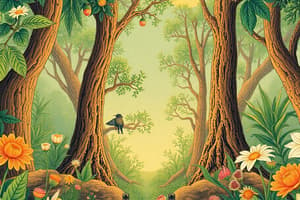Podcast
Questions and Answers
What is the term used to describe the identity of species present in a community?
What is the term used to describe the identity of species present in a community?
- Species composition (correct)
- Species richness
- Species diversity
- Relative abundance
Which of the following factors can lead to variation in community structure?
Which of the following factors can lead to variation in community structure?
- Environmental factors only
- Historical and spatial factors only
- Environmental, historical, and spatial factors (correct)
- None of the above
What is the term used to describe the range of ecological roles in a community?
What is the term used to describe the range of ecological roles in a community?
- Community structure
- Functional diversity (correct)
- Species diversity
- Genetic diversity
What is the process of change in community composition over time in response to disturbances or environmental changes?
What is the process of change in community composition over time in response to disturbances or environmental changes?
What can influence biodiversity in a community?
What can influence biodiversity in a community?
What is the term used to describe the organization and arrangement of species within a community?
What is the term used to describe the organization and arrangement of species within a community?
Which of the following is NOT a characteristic of a community?
Which of the following is NOT a characteristic of a community?
What can lead to the development of new ecosystems or habitats?
What can lead to the development of new ecosystems or habitats?
What refers to the proportion of individuals of each species in a community?
What refers to the proportion of individuals of each species in a community?
Which of the following can be described by species abundance distributions?
Which of the following can be described by species abundance distributions?
Flashcards are hidden until you start studying
Study Notes
Characteristics of a Community
- A group of species that co-occur in space and time
- Interact with each other through various mechanisms (e.g., competition, predation, mutualism)
- Can be characterized by:
- Species richness (number of species present)
- Species composition (identity of species present)
- Relative abundance (proportion of individuals of each species)
Community Structure
- Refers to the organization and arrangement of species within a community
- Can be described by:
- Species abundance distributions (e.g., evenness, dominance)
- Spatial patterns (e.g., patchiness, aggregation)
- Trophic structure (e.g., food webs, predator-prey relationships)
Variation in Community Structure
- Communities can vary in structure due to:
- Environmental factors (e.g., climate, topography, disturbance)
- Historical factors (e.g., colonization, extinction)
- Spatial factors (e.g., isolation, connectivity)
- This variation can lead to different community types or "assemblages"
Community Structure and Diversity
- Community structure can influence biodiversity:
- Species diversity (number of species present)
- Functional diversity (range of ecological roles)
- Genetic diversity (variability within and among species)
- Diversity can, in turn, affect community structure:
- Through processes such as niche partitioning and facilitation
Ecological Succession
- The process of change in community composition over time
- Can occur in response to:
- Disturbances (e.g., fire, flooding)
- Environmental changes (e.g., climate shift, soil degradation)
- Succession can lead to:
- Changes in species composition and abundance
- Shifts in community structure and function
- Development of new ecosystems or habitats
Characteristics of a Community
- A community consists of a group of species that co-occur in space and time.
- Species within a community interact with each other through mechanisms such as competition, predation, and mutualism.
- Communities are characterized by species richness, species composition, and relative abundance.
Community Structure
- Community structure refers to the organization and arrangement of species within a community.
- Species abundance distributions, such as evenness and dominance, describe community structure.
- Spatial patterns, like patchiness and aggregation, are also used to describe community structure.
- Trophic structure, including food webs and predator-prey relationships, is another aspect of community structure.
Variation in Community Structure
- Environmental factors, such as climate, topography, and disturbance, contribute to variation in community structure.
- Historical factors, like colonization and extinction, influence community structure.
- Spatial factors, including isolation and connectivity, affect community structure.
- These variations result in different community types or assemblages.
Community Structure and Diversity
- Community structure influences biodiversity, including species diversity, functional diversity, and genetic diversity.
- Diversity, in turn, affects community structure through processes such as niche partitioning and facilitation.
Ecological Succession
- Ecological succession is the process of change in community composition over time.
- Succession occurs in response to disturbances, environmental changes, climate shifts, and soil degradation.
- This process leads to changes in species composition and abundance, shifts in community structure and function, and the development of new ecosystems or habitats.
Studying That Suits You
Use AI to generate personalized quizzes and flashcards to suit your learning preferences.




